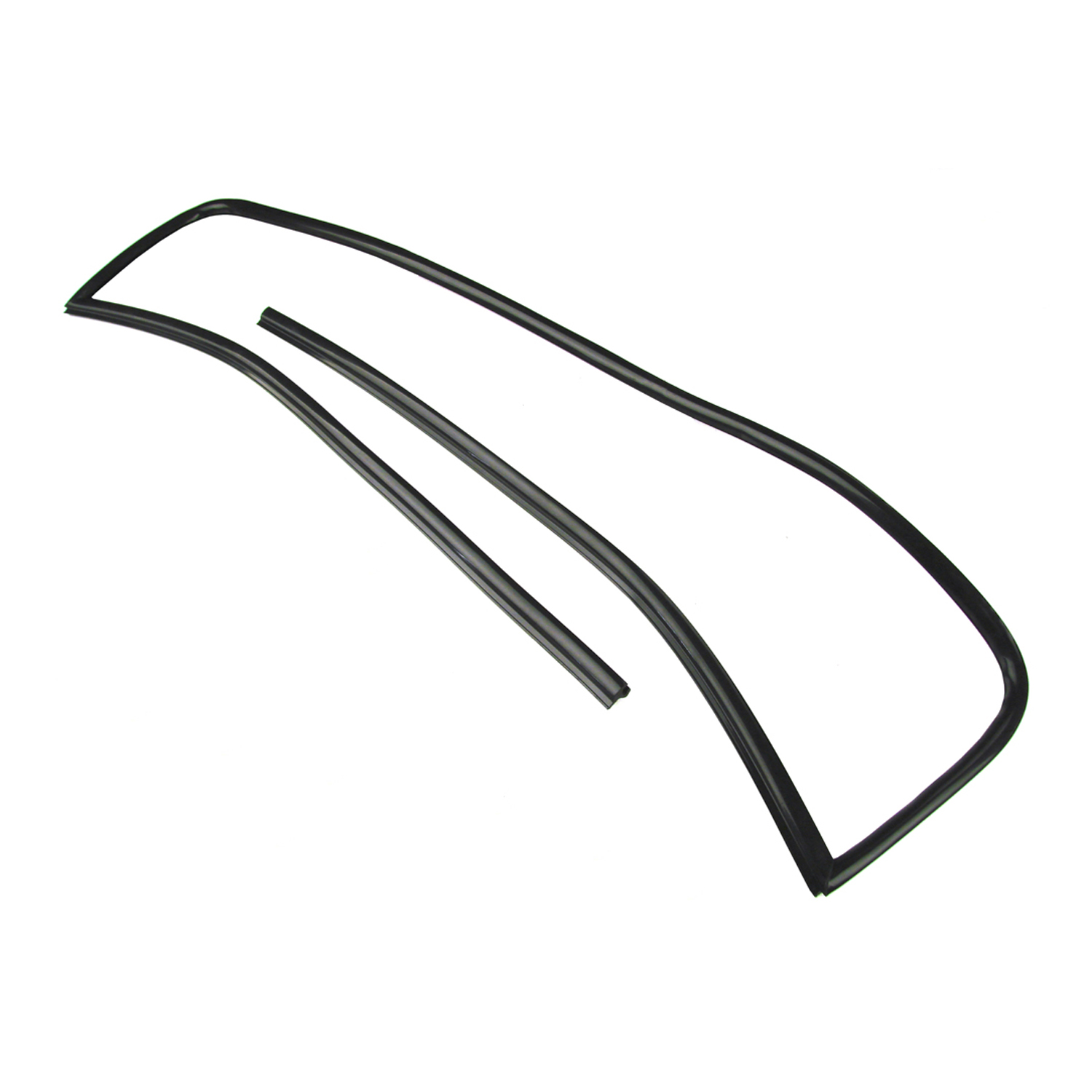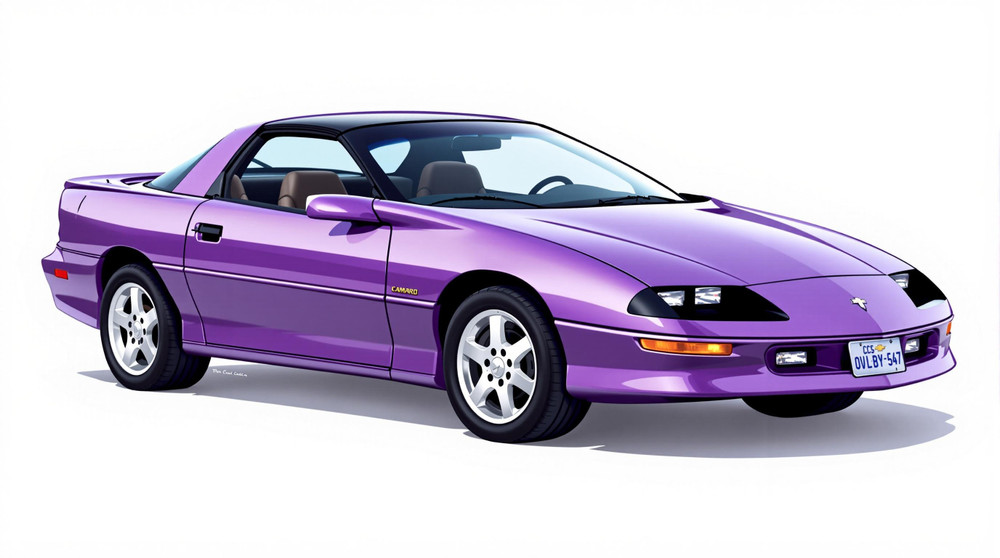Image of 1993 Chevrolet Camaro, Note: These illustrations use artistic license and may differ from actual historical models.
Performance Metrics
Fundamental Metrics
Emotional Appeal
MMP Rating
| Engine Specifications | |
|---|---|
| Engine Options: | 3.4L V6, 5.7L V8 |
| Displacement Range: | 207-350 cu in |
| Horsepower Range: | 160-275 hp |
| Torque: | 200-325 lb-ft |
| Compression Ratio: | 9.5:1 (V6), 10.5:1 (V8) |
| Ignition System: | Electronic |
| Cooling System: | Liquid-cooled |
| Performance Specifications | |
| 0-60 Time: | 7.6 seconds (V6), 5.7 seconds (V8) |
| 1/4 Mile Time: | 15.9 seconds (V6), 14.2 seconds (V8) |
| Top Speed: | 130 mph (V6), 155 mph (V8) |
| Transmission and Drive | |
| Drive Type: | RWD |
| Transmission Type: | 5-speed manual, 4-speed automatic |
| Fuel and Efficiency | |
| Fuel System Type: | Fuel injection |
| MPG: | 17 city / 25 highway (V6), 15 city / 23 highway (V8) |
| Dimensions and Brakes | |
| Brakes: | Front disc, rear drum |
| Wheelbase: | 101.1 inches |
| Weight: | 3,300-3,500 lbs |
Note: Specifications for classic cars are given to the best of our ability, considering the limited and variant data available.
Unveiling the 1993 Chevrolet Camaro: An American Icon Reimagined
The year 1993 marked the advent of a new era for the Chevrolet Camaro. This iconic American muscle car, birthed by General Motors in the late 1960s, was poised to redefine performance and style with its fourth-generation model. As the Camaro transitioned into this new phase, it carried with it a legacy of American automotive prowess and a reputation for being at the forefront of design and innovation. A unique fact that stands out in its illustrious history is that the '93 Camaro was chosen to pace the Indianapolis 500, a testament to its performance pedigree.
Design and Innovation: A Bold Step Forward
The exterior styling of the 1993 Chevrolet Camaro was a bold departure from its predecessors, featuring sleek lines that suggested speed even when stationary. The car's low-slung profile and aggressive stance were accentuated by a distinctive nose and pop-up headlights that became emblematic of its design ethos. Inside, drivers were greeted by an interior that focused on ergonomics, with controls angled towards the pilot and a dashboard that prioritized functionality without sacrificing style. The use of materials aimed to balance durability with comfort, reflecting the dual nature of the Camaro as both a performance machine and an everyday vehicle. Technological features for its time included electronic fuel injection and anti-lock brakes, while options like traction control were cutting-edge. Color options ranged from classic hues like Arctic White to vibrant Teal Pearl Metallic, with popular choices often highlighting the car's sporty lines. The most iconic body style was undoubtedly the coupe, which offered various trim levels including the base model, the sportier RS, and the high-performance Z28.
Historical Significance: More Than Just Muscle
The 1993 Camaro wasn't merely another chapter in muscle car history; it was a statement about where automotive design and technology could go. It set itself apart with an aerodynamic efficiency that was uncommon among its peers, contributing to better fuel economy and improved handling. This model's influence can be seen in how it helped usher in an era where sports cars were expected to deliver not just raw power but also sophistication and drivability.
Performance and Handling: The Thrill of American Muscle
Underneath its sculpted hood, the '93 Camaro could be equipped with various engines, but none more revered than the LT1 V8 found in the Z28 variant. This powerhouse propelled the Camaro from 0-60 mph in under six seconds, an impressive feat for its time. The top speed was electronically limited but still allowed drivers to experience exhilarating performance. Handling was enhanced by a well-tuned suspension system that managed to provide a balance between ride comfort and responsive handling on twisty roads or during spirited driving sessions. The sound of the V8 engine was unmistakable—a deep rumble that resonated with muscle car enthusiasts. Behind the wheel, drivers felt connected to the road through precise steering feedback and supportive seating that kept them firmly in place.
Ownership Experience: Living with a Legend
The 1993 Chevrolet Camaro found its place not just on racetracks or at car shows but also in the garages of everyday enthusiasts who used it as their daily driver. Its reliability was generally commendable for a performance vehicle of its era, though some components—like optispark distributors on LT1 engines—were known for needing attention. Maintenance could typically be performed by owners with some mechanical knowledge, keeping these machines roaring down roads years after they rolled off assembly lines.
Fun Facts: The Camaro's Place in Pop Culture
The '93 Camaro has graced various forms of media and has been associated with celebrities over time. While not necessarily rare editions, special models like the pace car replicas are highly sought after by collectors. Despite facing criticism over interior plastics or visibility issues, this generation of Camaro has held onto a dedicated fan base.
Collector's Information: Assessing Value and Rarity
As time marches on, fourth-generation Camaros are beginning to pique the interest of collectors. While production numbers were relatively high—with hundreds of thousands produced—finding one in pristine condition can be challenging. Values vary widely based on condition, mileage, and specification; however, well-kept Z28 models can command prices upwards of $20,000 or more depending on their provenance and originality. Price trends suggest appreciation for models in excellent condition or those with significant historical interest (like pace car editions). As younger enthusiasts enter the collector market, demand for these 90s icons is likely to increase.
Conclusion: Celebrating an Era-Defining Classic
The 1993 Chevrolet Camaro stands as a testament to an era when American muscle began embracing modernity without losing its raw appeal. It is remembered not only for its performance but also for how it made drivers feel—an embodiment of freedom on four wheels. As we look back at this chapter in automotive history, we can appreciate how it paved the way for future innovations while still stirring the souls of car lovers everywhere.
1993 Chevrolet Camaro Catalog of Parts
 1993 Chevrolet Camaro Windshield Seal, 93-02 GM F Body Coupe Without T-Top Option, Each-VWS 1967-MWindshield Seal, 93-02 GM F Body Coupe Without T-Top Option, Each. Replaces OEM #10284786. This seal fits the coupes without the t-top option. Has corner welds.
1993 Chevrolet Camaro Windshield Seal, 93-02 GM F Body Coupe Without T-Top Option, Each-VWS 1967-MWindshield Seal, 93-02 GM F Body Coupe Without T-Top Option, Each. Replaces OEM #10284786. This seal fits the coupes without the t-top option. Has corner welds. 1993 Chevrolet Camaro Windshield Seal, 93-02 GM F Body Coupe with T-Top Option, Each-VWS 1967-NWindshield Seal, 93-02 GM F Body Coupe with T-Top Option, Each. Replaces OEM #10293683. This seal fits the coupes with t-tops. Has corner welds.
1993 Chevrolet Camaro Windshield Seal, 93-02 GM F Body Coupe with T-Top Option, Each-VWS 1967-NWindshield Seal, 93-02 GM F Body Coupe with T-Top Option, Each. Replaces OEM #10293683. This seal fits the coupes with t-tops. Has corner welds.Why Choose Metro?
For over 100 years, Metro Moulded Parts has been the pinnacle of quality in classic car restoration parts. Our commitment to precision and authenticity in every component ensures a perfect fit and an OEM-level appearance.
- Expert Craftsmanship & Quality: Each part is a testament to our dedication to reliability and perfection, crafted from original designs and thoroughly tested.
- Advanced Technology: We use cutting-edge techniques to create flawless, long-lasting parts that surpass others in performance.
- SuperSoft Sponge – The Ultimate Door Seal: Not only are our door seals 30% softer than competitors', but they're also guaranteed to never leak. They effectively reduce wind and road noise, enhancing your classic car's comfort and driving experience.
- Proudly American: Our parts are a product of American craftsmanship, made in the USA with a spirit of excellence and heritage.
- Unrivaled Warranty: We back our products with a 30-year industry-leading warranty, a testament to our confidence in their quality.
Join us in preserving the legacy of classic cars with parts that are crafted for perfection, not just made.

